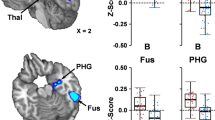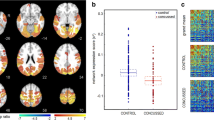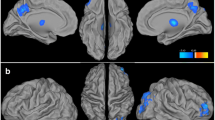Abstract
The search for effective treatment facilitating recovery from concussive injury, as well as reducing risk for recurrent concussion is an ongoing challenge. This study aimed to determine: a) feasibility of selective brain cooling to facilitate clinical symptoms resolution, and b) biological functions of the brain within athletes in acute phase of sports-related concussion. Selective brain cooling for 30 minutes using WElkins sideline cooling system was administered to student-athletes suffering concussive injury (n=12; tested within 5±3 days) and those without history of concussion (n=12). fMRI and ASL sequences were obtained before and immediately after cooling to better understanding the mechanism by which cooling affects neurovascular coupling. Concussed subjects self-reported temporary relief from physical symptoms after cooling. There were no differences in the number or strength of functional connections within Default Mode Network (DMN) between groups prior to cooling. However, we observed a reduction in the strength and number of connections of the DMN with other ROIs in both groups after cooling. Unexpectedly, we observed a significant increase in cerebral blood flow (CBF) assessed by ASL after selective cooling in the concussed subjects compared to the normal controls. We suggest that compromised neurovascular coupling in acute phase of injury may be temporarily restored by cooling to match CBF with surges in the metabolic demands of the brain. Upon further validation, selective brain cooling could be a potential clinical tool in the minimization of symptoms and pathological changes after concussion.




Similar content being viewed by others
References
Alexander, D. G., Shuttleworth-Edwards, A. B., Kidd, M., & Malcolm, C. M. (2015). Mild traumatic brain injuries in early adolescent rugby players: Long-term neurocognitive and academic outcomes. Brain Injury, 29(9), 1113–1125.
Aronov, D., & Fee, M. S. (2011). Analyzing the dynamics of brain circuits with temperature: Design and implementation of a miniature thermoelectric device. Journal of Neuroscience Methods, 197(1), 32–47.
Bagic, A., Theodore, W., Boudreau, E., Bonwetsch, R., Grennfield, J., Elkins, W., & Sato, S. (2008). Towards a non-invasive interictal application of hypothermia for treating seizures: A feasibility and pilot study. Acta Neurologica Scandinavica, 118, 240–244.
Bartnik-Olson, B. L., Holshouser, B., Wang, H., Grube, M., Tong, K., Wong, V., & Ashwal, S. (2014). Impaired neurovascular unit function contributes to persistent symptoms after concussion: A pilot study. Journal of Neurotrauma, 31, 1497–1506.
Behzadi, Y., Restom, K., Liau, J., & Liu, T. T. (2007). A component based noise correction method (CompCor) for BOLD and perfusion based fMRI. NeuroImage, 37(1), 90–101.
Dennis, B. H., Eberhart, R. C., Dulikravich, G. S., & Radons, S. W. (2003). Finite-element simulation of cooling of realistic 3-D human head and neck. Journal of Biomechanical Engineering, 125(6), 832–840.
Ellis, M. J., Leiter, J., Hall, T., McDonald, P. J., Sawyer, S., Silver, N., Bunge, M., & Essig, M. (2015). Neuroimaging findings in pediatric sports-related concussion. Journal of Neurosurgery. Pediatrics, 16(3), 241–247.
Ellis, M. J., Ryner, L. N., Sobczyk, O., Fierstra, J., Mikulis, D. J., Fisher, J. A., et al. (2016). Neuroimaging assessment of cerebrovascular reactivity in concussion: Current concepts, methodological considerations, and review of the literature. Frontiers in Neurology, 7, 61.
Giza, C. C., & Hovda, D. A. (2001). The neurometabolic cascade of concussion. Journal of Athletic Training, 36(3), 228–235.
Giza, C. C., & Hovda, D. A. (2014). The new neurometabolic cascade of concussion. Neurosurgery, 75(Suppl 4), S24–S33.
Grubenhoff, J. A., Deakyne, S. J., Brou, L., Bajaj, L., Comstock, R. D., & Kirkwood, M. W. (2014). Acute concussion symptom severity and delayed symptom resolution. Pediatrics, 134(1), 54–62.
Gu, X., Wei, Z. Z., Espinera, A., Lee, J. H., Ji, X., Wei, L., Dix, T. A., & Yu, S. P. (2015). Pharmacologically induced hypothermia attenuates traumatic brain injury in neonatal rats. Experimental Neurology, 267, 135–142.
Hardingham, N. R., & Larkman, A. U. (1998). Rapid report: The reliability of excitatory synaptic transmission in slices of rat cortex in vitro is temperature dependent. The Journal of Physiology, 15(507), 249–256.
Harris, B., Andrews, P. J. D., Murray, G. D., Forbes, J., & Moseley, O. (2012). Systemic review of head cooling in adults after traumatic brain injury and stroke. Health Technology Assessment, 16(45).
Helmich, I., Berger, A., & Lausberg, H. (2016). Neural control of posture in individuals with persisting postconcussion symptoms. Medicine and Science in Sports and Exercise, 48(12), 2362–2369.
Johnson, B., Zhang, K., Gay, M., Horovitz, S., Hallett, M., Sebastianelli, W., & Slobounov, S. (2012). Alteration of brain default network in subacute phase of injury in concussed individuals: Resting-state fMRI study. NeuroImage, 59(1), 511–518.
Johnson, B., Hallett, M., & Slobounov, S. (2015). Follow-up evaluation of oculomotor performance with fMRI in the subacute phase of concussion. Neurology, 85(13), 1163–1166.
Ku, Y. T., Montgomery, L. D., & Webbon, B. W. (1996). Hemodynamic and thermal responses to head and neck cooling in men and women. American Journal of Physical Medicine & Rehabilitation, 75(6), 443–450.
Langlois, J. A., Rutland-Brown, W., & Wald, M. M. (2006). The epidemiology and impact of traumatic brain injury: A brief overview. The Journal of Head Trauma Rehabilitation, 21(5), 375–378.
Lee, J. H., Wei, L., Gu, X., Wei, Z., Dix, T. A., & Yu, S. P. (2014). Therapeutic effects of pharmacologically induced hypothermia against traumatic brain injury in mice. Journal of Neurotrauma, 31(16), 1417–1430.
Liu, T., Zhao, D., Cui, H., Chen, L., Bao, Y., Wang, Y., & Jiang, J. (2016). Therapeutic hypothermia attenuates tissue damage and cytokine expression after traumatic brain injury by inhibiting necroptosis in the rat. Scientific Reports, 6, 24547.
Lovell, M. R., Collins, M. W., Iverson, G. L., Johnston, K. M., & Bradley, J. P. (2004). Grade 1 or “ding” concussions in high school athletes. The American Journal of Sports Medicine, 32(1), 47–54.
Maugans, T. A., Farley, C., Altaye, M., Leach, J., & Cecil, K. M. (2012). Pediatric sports-related concussion produces cerebral blood flow alterations. Pediatrics, 129, 28–37.
McCrory, P., Meeuwisse, W. H., Aubry, M., Cantu, R. C., Dvořák, J., Echemendia, R. J., Engebretsen, L., Johnston, K., Kutcher, J. S., Raftery, M., Sills, A., Benson, B. W., Davis, G. A., Ellenbogen, R., Guskiewicz, K. M., Herring, S. A., Iverson, G. L., Jordan, B. D., Kissick, J., McCrea, M., McIntosh, A. S., Maddocks, D., Makdissi, M., Purcell, L., Putukian, M., Schneider, K., Tator, C. H., & Turner, M. (2012). Consensus statement on concussion in sport: the 4th International Conference on Concussion in Sport held in Zurich. British Journal of Sports Medicine, 47, 250–258.
Meier, T. B., Bellgowan, P. S., Singh, R., Kuplicki, R., Polanski, D. W., & Mayer, A. R. (2015). Recovery of cerebral blood flow following sports-related concussion. JAMA Neurology, 72(5), 530–538.
Micheva, K. D., & Smith, S. J. (2005). Strong effects of subphysiological temperature on the function and plasticity of mammalian presynaptic terminals. The Journal of Neuroscience, 25(33), 7481–7488.
Minamisawa, H., Smith, M. L., & Siesjo, B. K. (1990). The effect of mild hypothermia and hypothermia on brain damage following 5, 10, and 15 minutes of forebrain ischemia. Annals of Neurology, 28(1), 26–33.
Montenigro, P. H., Alosco, M. L., Martin, B. M., Daneshvar, D. H., Mez, J., Chaisson, C. E., et al. (2017). Cumulative head impact exposure predicts later-life depression, apathy, executive dysfunction, and cognitive impairment in former high school and college football players. Journal of Neurotrauma, 34(2), 328–340.
Murphy, K., Birn, R. M., Handwerker, D. A., Jones, T. B., & Bandettini, P. A. (2009). The impact of global signal regression on resting state correlations: Are anti-correlated networks introduced? NeuroImage, 44(3), 893–905.
Ponz, I., Lopez-de-Sa, E., Armada, E., Caro, J., Blazquez, Z., Rosillo, S., Gonzalez, O., Rey, J. R., Monedero, M. C., & Lopez-Sendon, J. L. (2016). Influence of the temperature on the moment of awakening in patients treated with therapeutic hypothermia after cardiac arrest. Resuscitation, 103, 32–36.
Raichle, M. E. (2015). The brain’s default mode network. Annual Review of Neuroscience, 38, 433–447
Rosomoff, H. L., & Holaday, D. A. (1954). Cerebral blood flow and cerebral oxygen consumption during hypothermia. The American Journal of Physiology, 179(1), 85–88.
Roy, C. S., & Sherrington, C. S. (1890). On the regulation of the blood supply of the brain. The Journal of Physiology, 11, 85–108.
Sakurai, A., Atkins, C. M., Alonso, O. F., Bramlett, H. M., & Dietrich, W. D. (2012). Mild hyperthermia worsens the neuropathological damage associated with mild traumatic brain injury in rats. Journal of Neurotrauma, 29(2), 313–321.
Slobounov, S., Zhang, K., Pennell, D., Ray, W., Johnson, B., & Sebastianelli, W. (2010). Functional abnormalities in normally appearing athletes following mild traumatic brain injury: A functional MRI study. Experimental Brain Research, 202(2), 341–354.
Slobounov, S., Bazarian, J., Bigler, E., Cantu, R., Hallett, M., Harbaugh, R., Hovda, D., Mayer, A. R., Nuwer, M. R., Kou, Z., Lazzarino, G., Papa, L., & Vagnozzi, R. (2014). Sports-related concussion: Ongoing debate. British Journal of Sports Medicine, 48(2), 75–76.
Smith, A. L., Rosenkrantz, T. S., & Fitch, R. H. (2016). Effects of sex and mild intrainsult hypothermia on neuropathology and neural reorganization following neonatal hypoxic ischemic brain injury in rats. Neural Plasticity, 1–11.
Tak, S., Polimeni, J. R., Wang, D. J. J., Yan, L., & Chen, J. J. (2015). Associations of resting-state fMRI functional connectivity with flow-BOLD coupling and regional vasculature. Brain Connectivity, 5(3), 137–146.
Talavage, T. M., Nauman, E. A., Breedlove, E. L., Yoruk, U., Dye, A. E., Morigaki, K. E., Feuer, H., & Leverenz, L. J. (2014). Functionally-detected cognitive impairment in high school football players without clinically-diagnosed concussion. Journal of Neurotrauma, 31(4), 327–338.
Talavage, T. M., Nauman, E. A., & Leverenz, L. J. (2016). The role of medical imaging in the recharacterization of mild traumatic brain injury using youth sports as a laboratory. Frontiers in Neurology, 19(6), 273.
Taschenberger, H., & von Gersdorff, H. (2000). Fine-tuning an auditory synapse for speed and fidelity: Developmental changes in presynaptic waveforms, EPSC kinetics, and synaptic plasticity. The Journal of Neuroscience, 20(24), 9162–9173.
Titus, D. J., Furones, C., Atkins, C. M., & Dietrich, W. D. (2015). Emergence of cognitive deficits after mild traumatic brain injury due to hypothermia. Experimental Neurology, 263, 254–262.
Velarde, F., Fisher, D. T., & Hovda, D. A. (1992). Fluid percussion injury induces prolonged changes in cerebral blood flow. Journal of Neurotrauma, 9(402).
Volgushev, M., Vidyasagar, T. R., Chistiakova, M., & Eysel, U. T. (2000). Synaptic transmission in the neocortex during reversible cooling. Neuroscience, 98(1), 9–22.
Wang, J., Licht, D. J., Jahng, G.-H., Liu, C.-S., Rubin, J. T., Haselgrove, J., et al. (2003). Pediatric perfusion imaging using pulsed arterial spin labeling. J Magn Reson Imaging: JMRI, 18(4), 404–413.
Wang, H., Olivero, W., Lanzino, G., Elkins, W., Rose, J., Honings, D., et al. (2004). Rapid and selective cerebral hypothermia achieved using a cooling helmet. Journal of Neurosurgery, 100(2), 272–277.
Wang, Y., Nelson, L. D., LaRoche, A. A., Pfaller, A. Y., Nencka, A. S., Koch, K. M., & McCrea, M. A. (2015). Cerebral blood flow alterations in acute sport-related concussion. Journal of Neurotrauma, 33(13), 1227–1236.
Williams, G. R., & Spencer, F. C. (1958). The clinical use of hypothermia following cardiac arrest. Annals of Surgery, 148(3), 462–466.
Wood, T., Osredkar, D., Puchades, M., Maes, E., Falck, M., Flatebo, T., Walloe, L., Sabir, H., & Thoresen, M. (2016). Treatment temperature and insult severity influence the neuroprotective effects of therapeutic hypothermia. Scientific Reports, 6(23430), 1–12.
Zhang, K., Johnson, B., Pennell, D., Ray, W., Sebastianelli, W., & Slobounov, S. (2010). Are functional deficits in concussed individuals consistent with white matter structural alterations: Combined FMRI & DTI study. Experimental Brain Research, 204(1), 57–70.
Zhang, K., Johnson, B., Gay, M., Horovitz, S. G., Hallett, M., Sebastianelli, W., & Slobounov, S. (2012). Default mode network in concussed individuals in response to the YMCA physical stress test. Journal of Neurotrauma, 29(5), 756–765.
Zhu, D. C., Covassin, T., Nogle, S., Doyle, S., Russell, D., Pearson, R. L., Monroe, J., Liszewski, C. M., DeMarco, J. K., & Kaufman, D. I. (2014). A potential biomarker in sports-related concussion: Brain functional connectivity alteration of the default-mode network measure with longitudinal resting-state fMRI over thirty days. Journal of Neurotrauma, 32(5), 327–341.
Acknowledgements
This study was supported by Spartan Medical, Inc. and Welkins, LLC. The authors would like to thank the Penn State student-athletes who participated in this study. We would like to express special thanks to Siemens AG, Healthcare Sector for providing us with the advanced 3D ASL WIPS package.
Author information
Authors and Affiliations
Corresponding author
Ethics declarations
Author disclosure statement
All authors have no financial interests to disclose.
Electronic supplementary material
ESM 1
(DOCX 903 kb)
Rights and permissions
About this article
Cite this article
Walter, A., Finelli, K., Bai, X. et al. Neurobiological effect of selective brain cooling after concussive injury. Brain Imaging and Behavior 12, 891–900 (2018). https://doi.org/10.1007/s11682-017-9755-2
Published:
Issue Date:
DOI: https://doi.org/10.1007/s11682-017-9755-2




